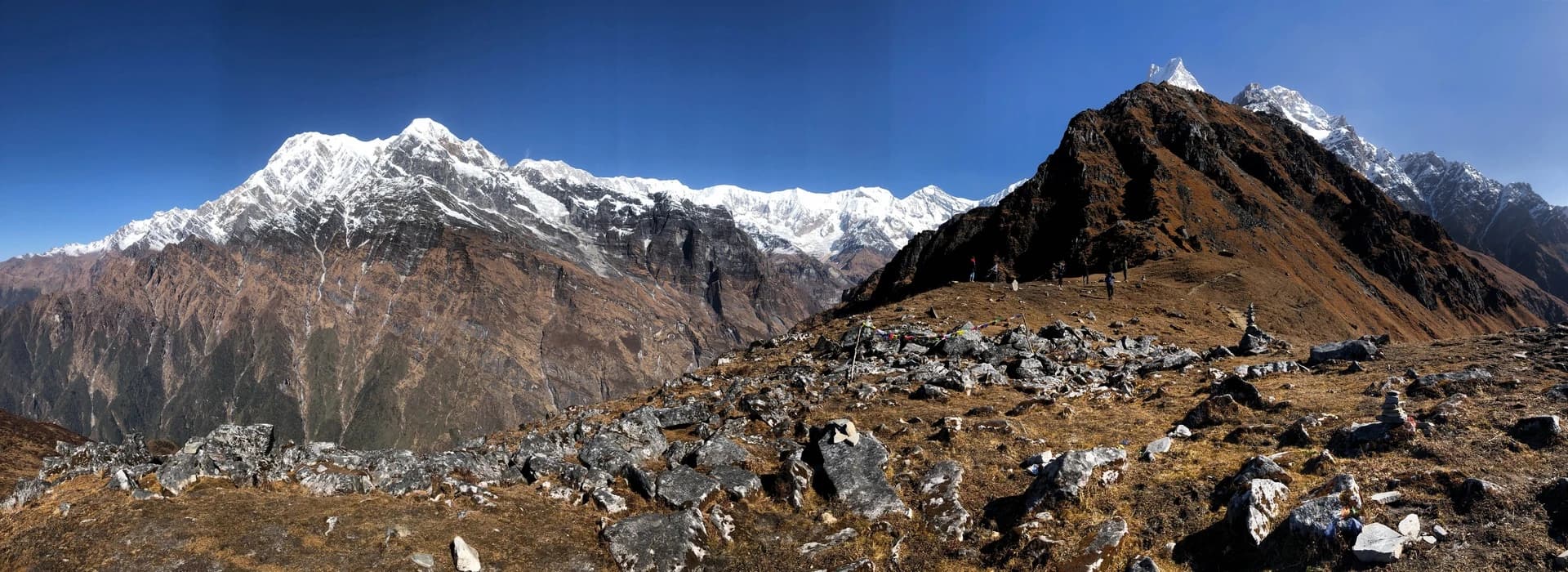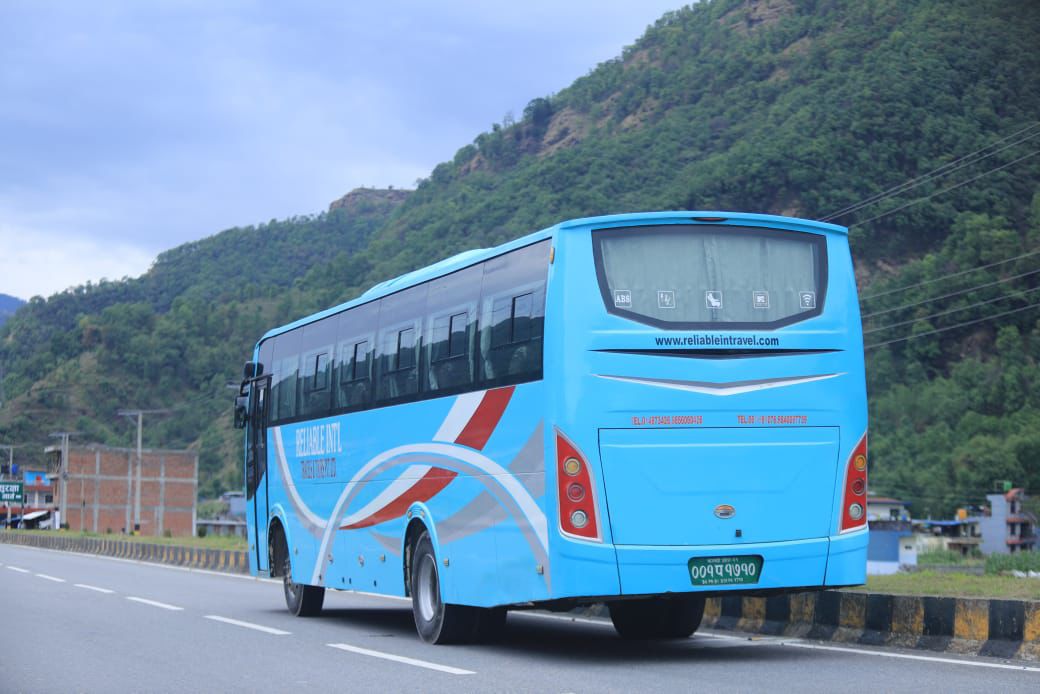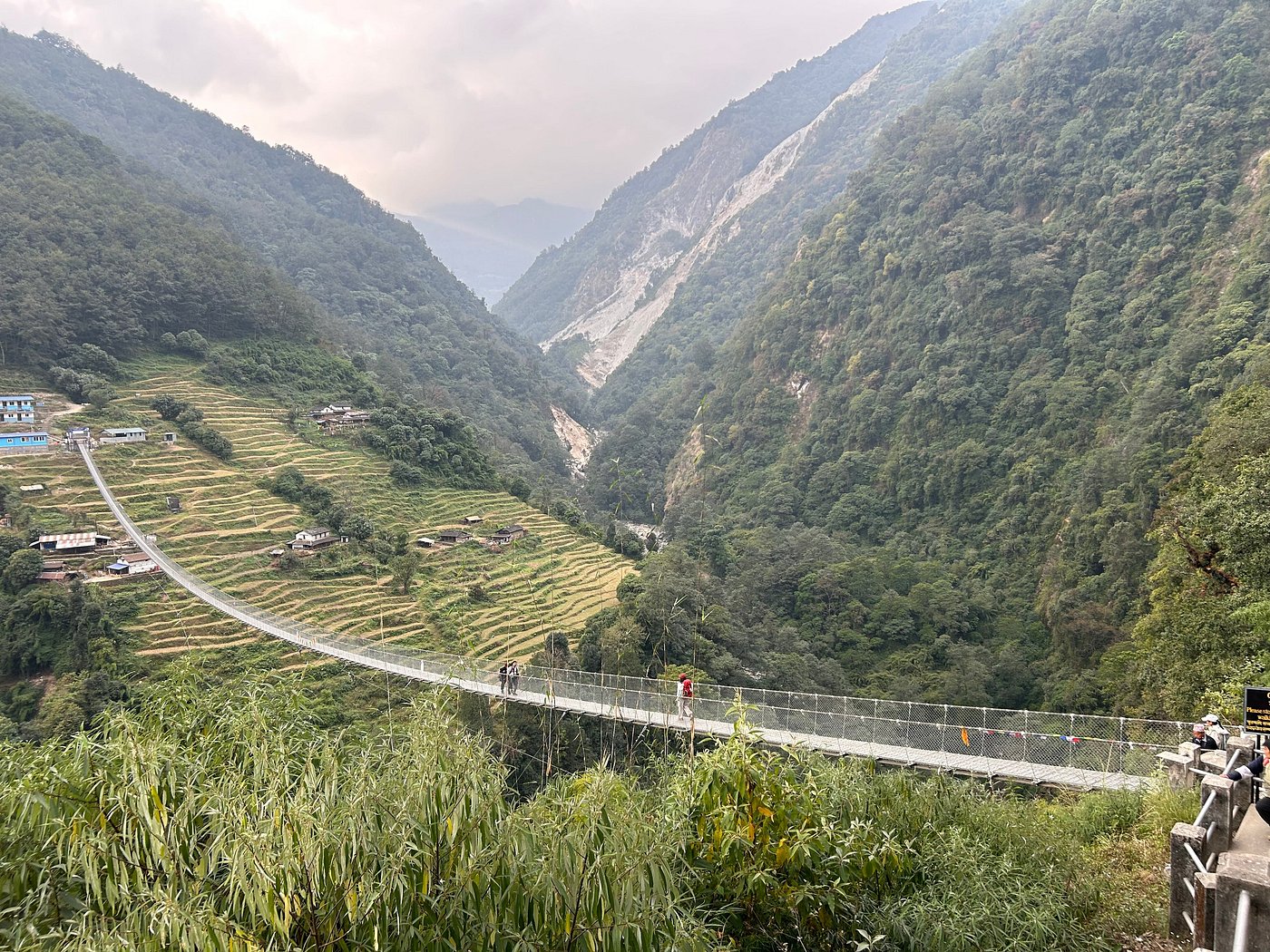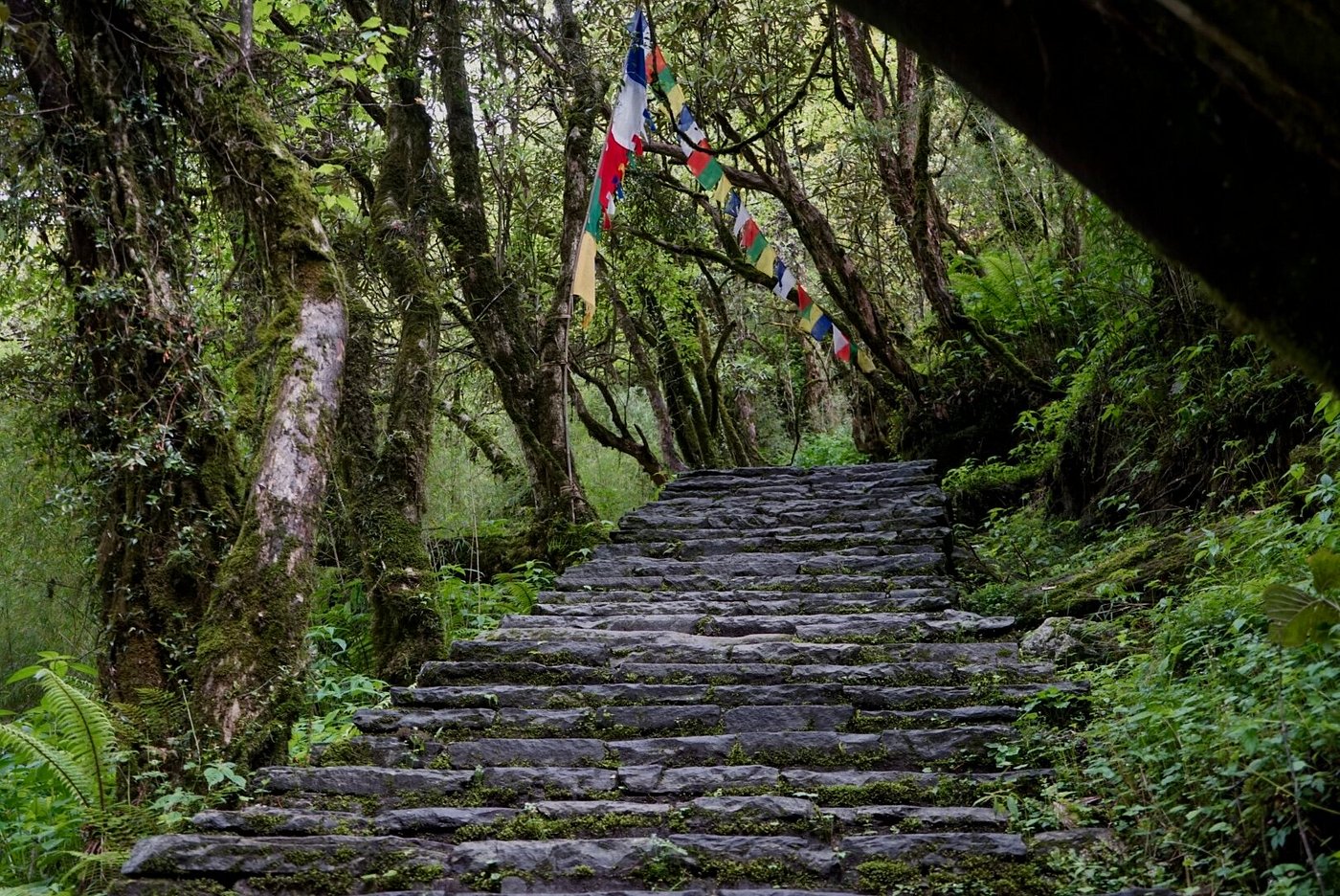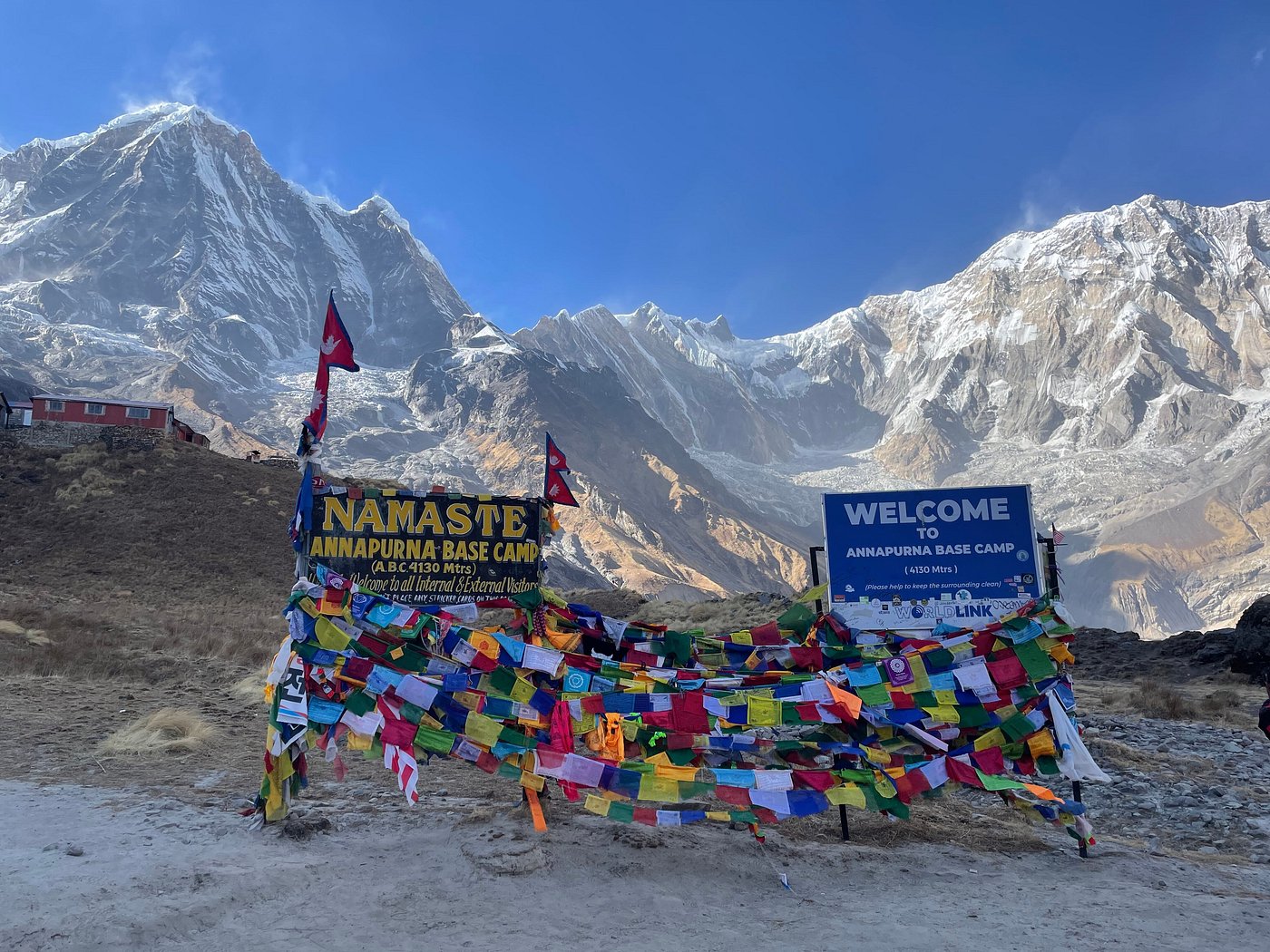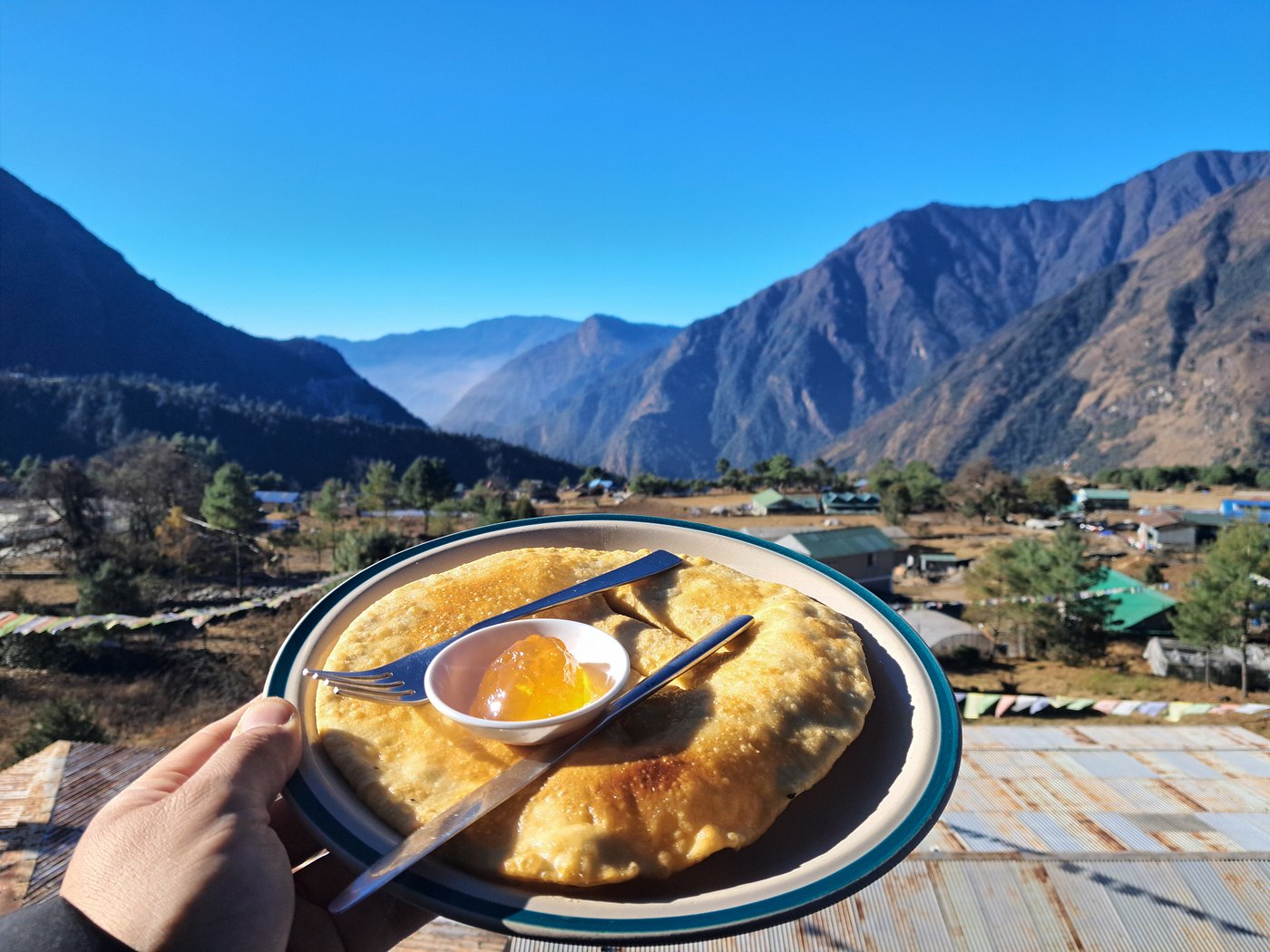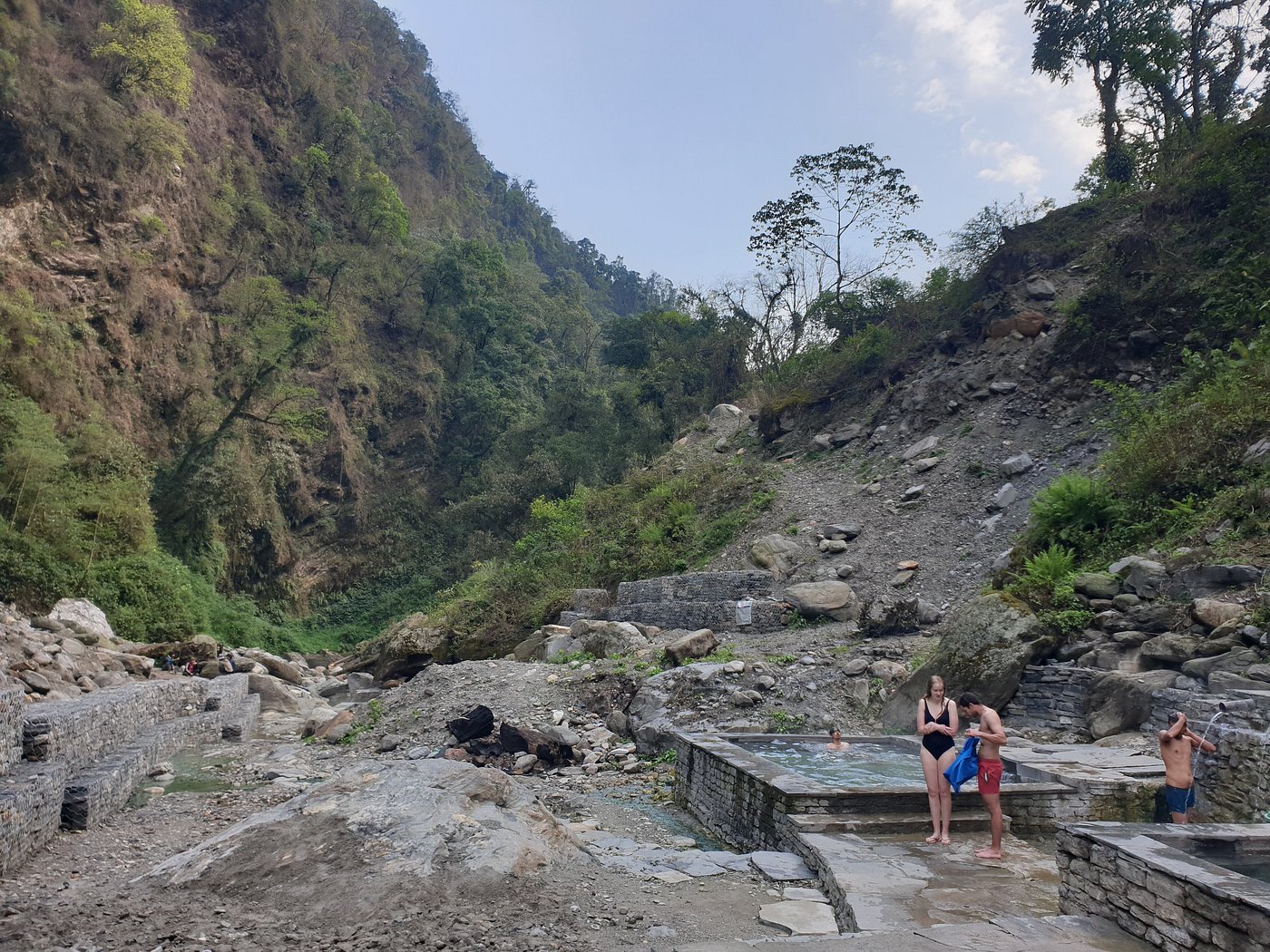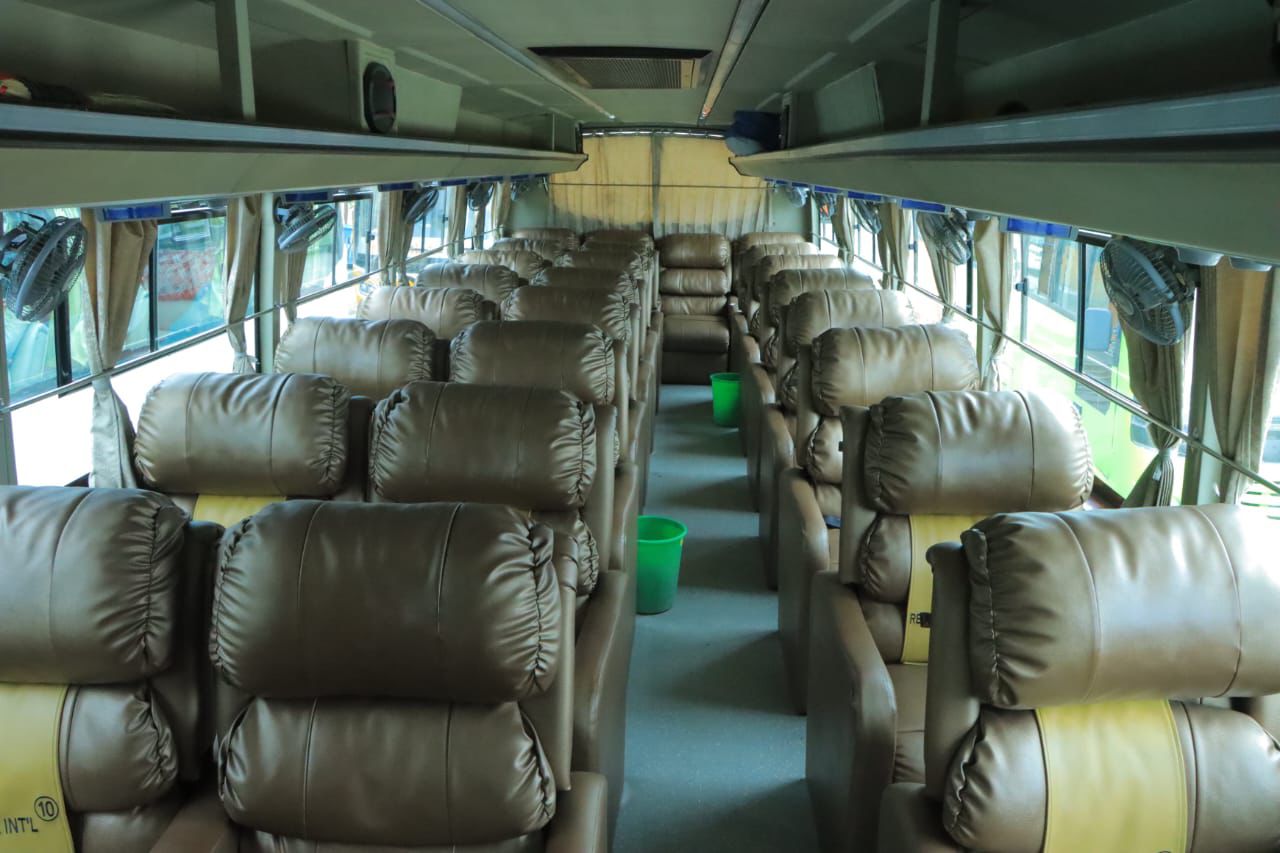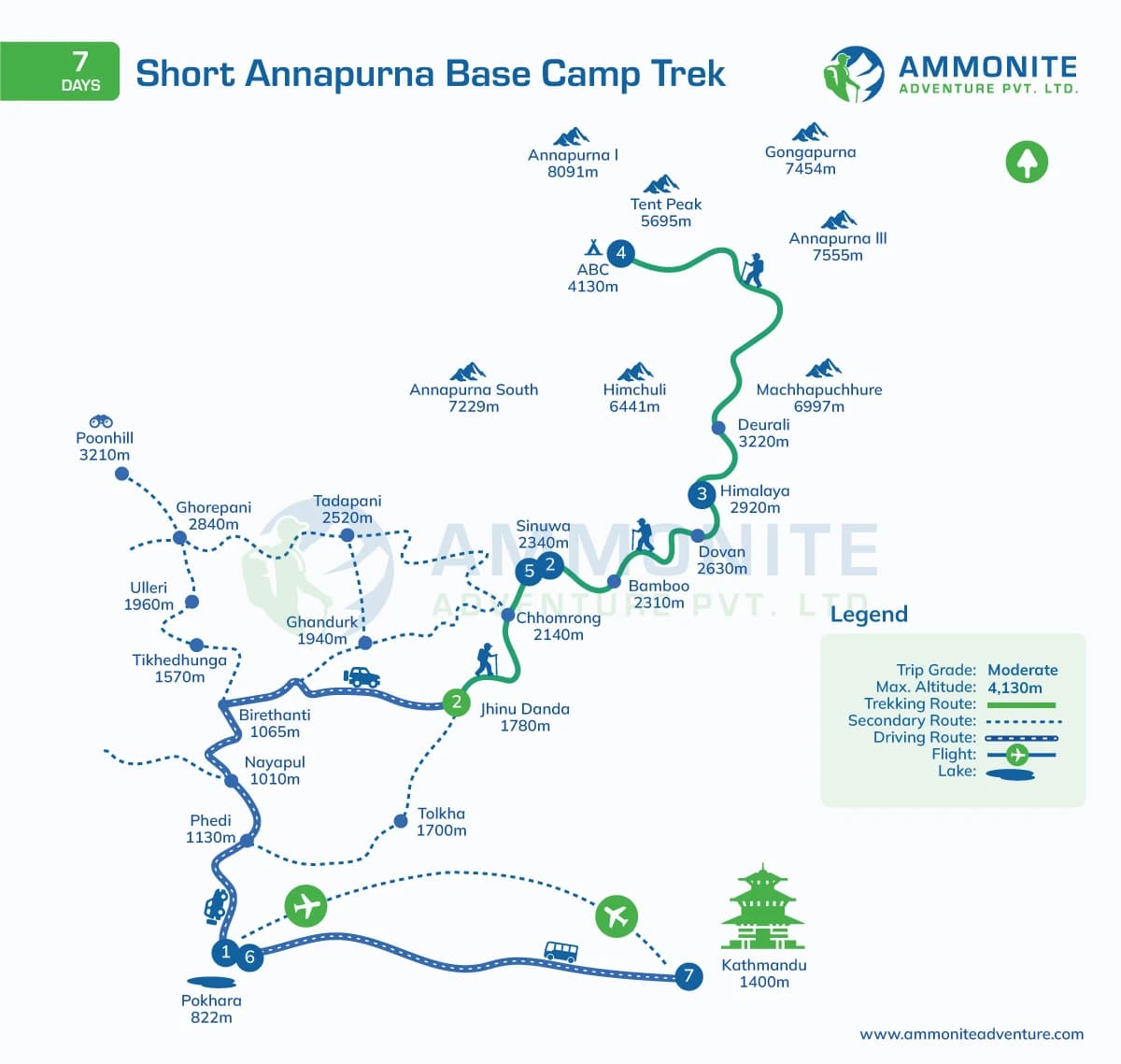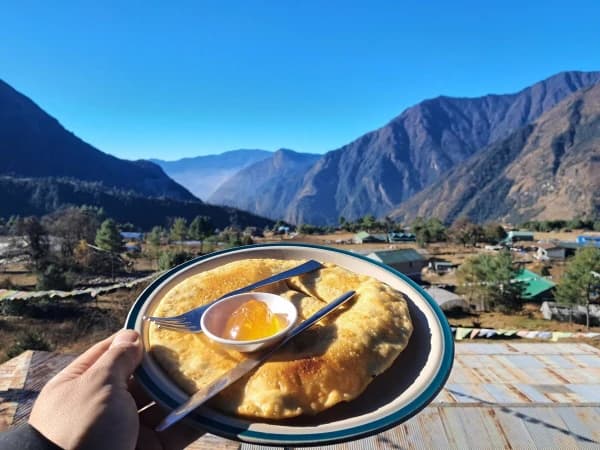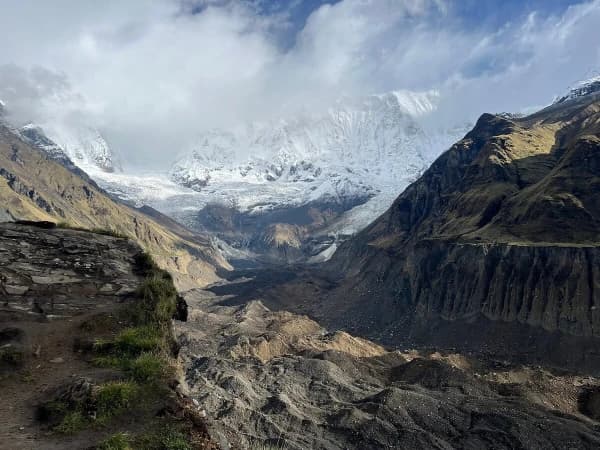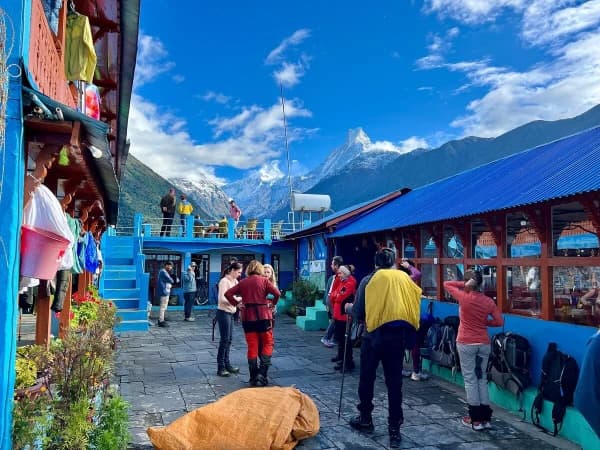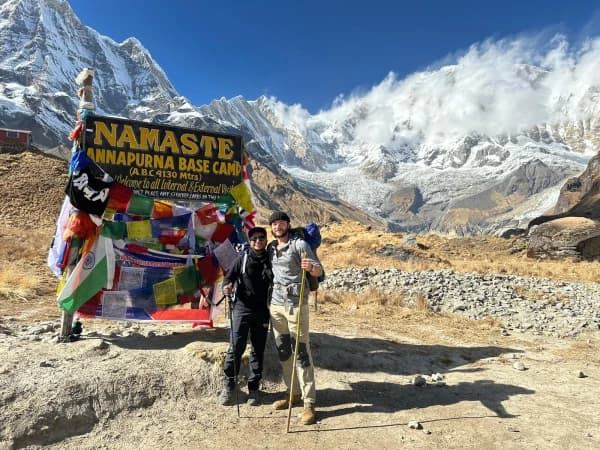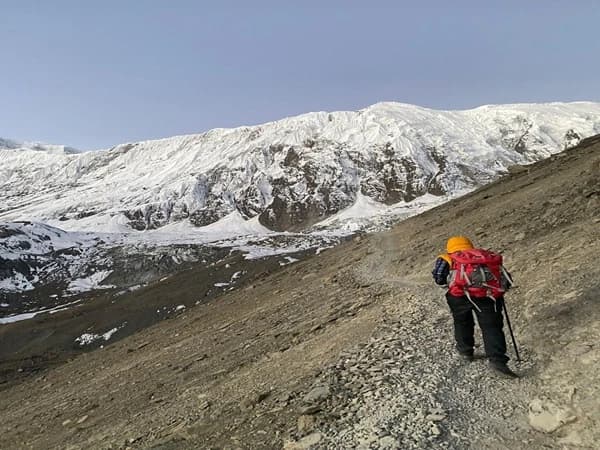We started the trek as a group of 9. 5
Short ABC Trek - 7 Days Trip Overview
The short Annapurna Base Camp Trek is truly rewarding considering all the picturesque spots, cultural insight and natural beauty it presents within a scale of just 6-7 days. It offers breathtaking scenery of the whole 360- degree Annapurna Himalayan range including views of iconic peaks such as Annapurna I (8,091 m), Annapurna II (7,937 m), Annapurna III (7,555 m), Annapurna IV (7,525 m), Annapurna South (7,219 m), Gangapurna (7,455 m), Daulagiri (8,167 m), Machapuchhre (6,993 m), Hiunchuli (6,441 m), Tilicho peak (7,134 m) and Mt. Nilgiri (7,061 m).
Along with magnificent views of mountains, you will get to experience the authentic Gurung and Magar cultures. You will have the opportunity to visit the cultural ethnic Nepali settlements and to traditional Tibetan-style villages in Chhomrong, Deurali and Bamboo, diverse landscapes ranging from lush forests to high-altitude terrain, cascading waterfalls and rivers like the Modi Khola. You might also have a rare chance to spot rare wildlife like Blue sheep and Snow leopards.
Your journey begins with a scenic drive from Kathmandu to Pokhara. Pokhara itself is a beautiful city and is considered Nepal's adventure hub and gateway to multiple treks. The following day you will drive to Jhinu Danda where your trek begins taking you through beautiful terraced fields and scenic villages and stop at Sinuwav overnight.
On the third day your trek continues passing through dense bamboo and rhododendron forests to Himalaya. Your accent through Mchhapuchhre base camp will be on the 4th day. At this point in the trek, we will already be at 3,700 m altitude. We continue to trek to Annapurna Base Camp at the end of the day reaching 4,130 m altitude. Throughout the trek, we will acclimatize as we stop at various locations overnight.
Upon arrival, we enjoy the 360-degree view of iconic Himalayan peaks at the Annapurna Sanctuary. Following up with the aesthetically pleasing sunset view on the Annapurna. We descend early in the morning on the 5th day of the trek back through the same route to Sinuwa. The following day we hike down to Jhinu Danda and enjoy the natural hot springs and release the tension from our body from all the trekking. Follow up with a short distance hike to Simroong and take a scenic drive back to Pokhara for a relaxing evening and marking the end of the journey.
On the 7th day you can either choose to stay in Pokhara for additional days or drive back to Kathmandu and check into your hotel.
This itinerary is designed to make trekking a journey comfortable for beginners who can enjoy the wonders of nature and witness the beautiful culture of the Himalayan region in a short
amount of time. Being physically and mentally fit is always preferred for more exciting experiences. Overall, ABC Short Trek is the best option for those looking for an inclusive experience in a short period of time. If you ever visit Nepal this trip is a must!
Here are some key attractions and experiences on Short Trekking to Annapurna Base Camp:
Highlights of Short Annapurna Base Camp Trek
- The golden sunrise and sunset on the snow-caped Giants i.e. The Annapurna sanctuary has an up close view of surrounding peaks like Machhapuchhre ( Fishtail- 6,993 m), Hiunchuli and Gangapurna.
- The Annapurna Base Camp (4,130 m), standing at one of the world's highest peaks and enjoying a 360° view of Himalayan range.
- Machhapuchhre Base Camp- the gateway to Annapurna Base Camp. First opportunity to get a wide panoramic view of the Annapurna Sanctuary during trek.
- Switching from Rhododendron forests, bamboo groves to icy high-altitude zones between a few days.
- Enjoy Natural Hot Springs at Jhinu Danda by the Modi Khola to recover all the energy after several days of trekking.
- Cultural immersion, witness traditional Gurung and Magar villages in Chhomrong and Sinuwa. Taste the essence of daily life on mountains and experience the hospitality of local teahouses.
- Scenic Drives through Kathmandu to Pokhara and to Simroong.
- Annapurna Conservation Area, rare sightings of Himalayan wildlife such as Langurs, Mountain Goats and a variety of bird species.
- Countless Photography Opportunities, The stunning views of ABC and Machhapuchhre Base Camp (MBC), misty magical forests, crossing clear rivers, beautiful local Villages, traditional prayer flags and snow giants.
Why choose Annapurna Base Camp Short Trip?
ABC Trek is one of the most popular and rewarding treks in Nepal offering breathtaking views of Annapurna range as well as diverse landscapes. This trek allows you to enjoy the beauty of the mountain region even with limited time and no intense trekking.
Here are a list of reasons why the short Annapurna base camp trek would be an ideal trek for you :
Well-defined trail: The straightforward trail is suitable for long hiking hours. The well marked trackers help to navigate directions and make it ideal for people to explore the trail safely.
Budget friendly: The ABC Trek is renowned for being affordable yet really rewarding. And the cost may differ according to the type of service and accommodation used however this 7 day long trek is definitely less expensive and also Ammonet Adventure can provide you with a customized itinerary according to your budget and requirement.
Moderate elevation: The highest point to reach during this trip is 4,130 m (13,550 ft) at Annapurna Base Camp since there are no high passes included on this route there are less chances of altitude sickness.
Cultural immersion: The route passes through several authentic Gurung and Magar villages giving you an opportunity to learn about local lifestyle and culture in the mountains.
Natural hot springs: all the muscle pain and exhaustion from hiking for several days will be healed in the hot natural springs located in Jhinu Danda and spend some time relaxing and connecting with nature.
This itinerary provides a well-rounded trekking experience with a perfect blend of natural beauty, cultural richness and budget friendly. You will get quite the adventure at this price so it is a must do for anyone visiting Nepal whether they are experienced or novice trekkers.
Short - Annapurna Base Camp Trek Vs Annapurna Base Camp Trek
| On the basis of | Short ABC Trek | ABC Trek |
| Duration | 5-7 days | 10-14 Days |
| Level of Difficulty | Moderate to challenging, demands good physical fitness and minimal trekking experience | Moderate, ideal for beginners with good fitness |
| Cost | Cheaper due to shorter duration |
More expensive due to longer duration |
| Acclimatization | Less days for acclimatization, high chances of altitude sickness if not careful. | Enough acclimatization days allows for comfortable ascent |
| Trekking distance | Comparatively shorter i.e. 60km / 37 miles | Longer distance i.e. 97km / 60 miles |
| Rewards | Cultural immersion, stunning mountain views, fewer side trips due to limited duration. | Everything you get in short ABC trek with additional time for exploration, more side trips as well |
How difficult is the Short Annapurna Base Camp trekking?
With Annapurna Base Camp at 4,130 m, this trek is considered moderately challenging. Any person with good physical fitness and light training of 2 to 3 weeks or multiple days of hiking experience prior to the trek is suitable for this trip.
The main challenge during the trek is long trekking hours, climbing steep stone staircases, and adapting to the high altitude. Here is a detailed explanation of how the intensity of short ABC trek increases as we move further:
First Day of trekking - On the first day of the journey we trek for 3 to 4 hours. The difference in altitude after the ascent is 500 m. The first day is considered mostly easy and a gentle start despite a few stone steps.
Second Day of trekking - The second day is considered a little bit more intense as we have to trek for 6 to 7 hours. Regan about 1,000 m altitude difference after the ascent. Besides intense hiking it is still considered moderately challenging. The steep steps descending from Chhomrong and the steady climb afterwards are the most difficult parts of this day.
Third Day of trekking - Like the previous day, we hike for 6 to 7 hours and gain an altitude difference of 1,200 m. You can feel the difficulty of the journey increasing as we get closer to ABC. The high altitude makes everything harder.
Fourth Day of trekking - After the third day, you will feel the difficulty of the trek is now moderate even though the hike takes place for 7 to 8 hours which is the longest time we hike in a day during the whole trip. On the fourth day we mostly descend so it is not as difficult as trekking to high altitude. The difficulty to be faced on this day is definitely the long day hike, few uphill near end but overall it is mostly descending.
Fifth Day of trekking - This has to be the most relaxing and easiest day in the whole journey as we only descend for 2 to 3 hours and enjoy the rest of the journey through a scenic drive. Consider this short hike as the final walk of your journey before the drive to Pokhara.
Pro Tip💡: Remember to maintain your pace and hydration as it is crucial for long ascent to higher altitudes.
How should I prepare for the short Annapurna base camp Trek?
Not to worry! because you do not have to go through intense training and experience to undertake the short Annapurna base camp trek. It is beginner friendly and only requires you to have a good level of physical fitness and stamina. While being short, Annapurna base camp trek does require a good level of physical fitness and stamina.
However, prior preparation for the trek will make your journey more easier and less exhausting. I suggest you start prepping for the trek at least one or two months prior. Here are some of the suggestions :
Physical Preparation for Short ABC Trek:
To prepare yourself physically for short ABC trek here are following suggestions:
Walking : For at least 1 to 2 months in advance, walk 10 to 15 km on average regularly to keep yourself in good shape. It helps to enhance your stamina and flexibility.
Regular exercise : Include exercises such as running, cycling, sprinting, skipping or swimming do enhance overall mobility of your body. Regular exercises also helps to regulate your mind and increase your confidence.
Strength Training : Simple strength training activities in the gym can enhance your muscle quality and endurance. So consider including squats, lunges, planks, leg press etc to build overall strengths.
Mental preparation for Short ABC Trek :
Mental preparation is just as important as physical preparation. A strong mind helps you keep calm during unexpected situations and improve your mental strength. If you're having a hard time trying to finish this trek just remember the beautiful scenery and the wonderful experience rather than their setbacks.
Make sure you research about the trek, what to expect and its challenges to help you set real expectations and prevent cultural shock as well as prepare accordingly.
Meditation & Yoga : Indulge in activities such as meditation and yoga to calm your mind and improve your nervous and regulatory system.
Positive Attitude : Keeping a positive outlook on various aspects before, during and after the journey is crucial for a successful adventure. It helps you overcome challenges and enjoy the journey despite some hardships.
Self-confidence : Especially for beginner trekkers, It is crucial to believe in yourself and your skills to embark on any trekking journey. Second guessing yourself can lead to wrong decision making and keep you away from reaching your highest potential.
What is the best season for Annapurna Base Camp Short Trip?
Even if you are going for trekking in general, it is crucial to pick the best season according to your preferences. Most of the travelers prefer to visit in the best seasons to get the most out of the stunning views and weather conditions while keeping safety on check. Spring (March - May) is considered one of the best seasons for this trek since the days are longer with many hours for sunlight from early 6:00 a.m. to late 6:00 p.m. during this season.
You will get to see various wildflowers around this time in the season with colorful hills with blossoming flowers especially the rhododendron blooming from tall trees to high bushes. The weather is milder and stable offering clear uninterrupted mountain views. Autumn (September - November) is another best alternative with a refreshing atmosphere and comfortable weather conditions.
For easier understanding, here are the different temperatures at different seasons to be aware of extremes of seasons during the trek.
| Seasons |
Temperature During Day time |
Temperature During Night Time |
| Spring (Mar-May) | 5° c to 15° c | -5° c to 0° c |
|
Summer/Monsoon (Jun-Aug) |
10° c to 20° c | 0° c to 5° c |
| Autumn (Sep-Nov) | 5° c to 15° c | -5° c to -2° c |
| Winter (Dec-Feb) | -5° c to 5° c | -10° c to -20° c |
I advise you to embark on this journey during these seasons for a more comfortable experience and crystal clear views of the mountains.
Ammonite Adventure does not recommend you to trek in the summer or winter season since the weather can be harsh and challenging but if your holiday is scheduled during summer time we would be pleased to plan a well prepared trip to the Annapurna region and make your visit worth a while.

